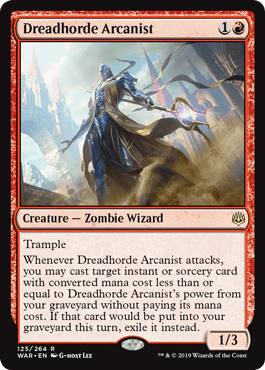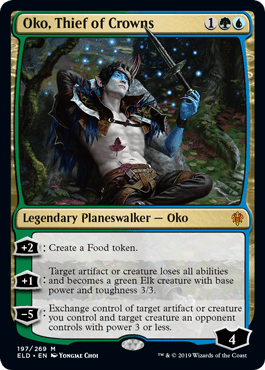Matchup Analysis: Legacy Maverick vs RUG Delver
Welcome back to the second instalment of the GreenSunsZenith.com’s Maverick matchup series! This series will be a breakdown of Legacy Maverick’s matchups and how you should approach different strategies in the format.
Rich Cali is a household name in the MTG community and even more so in the Legacy community. He’s a writer for Channel Fireball, a very experienced player and all round great person. A huge thank you to Rich for his insights from the RUG Delver side of the table. Lastly, another huge thank you to my Patreon supporters for supporting this type of content!
Contents:
1. Decklists
2. Introduction into RUG Delver
3. Matchup History
4. RUG Delver’s Game plan
5. Sideboarding Strategy
6. Tips & Tricks
7. Conclusions
8. Previous Matchup Series
9. Coverage & Resources
1. Decklists
Thanks to Rich for supplying a RUG Delver list. The Abzan list is becoming quite stock so I’m more than happy to use it again for this analysis.
RUG Delver
Planeswalkers
Creatures
Spells
Lands
Sideboard
Abzan Maverick:
Creatures
Spells
Lands
Sideboard
2. Introduction into RUG Delver
RUG Delver is an aggressively slanted midrange deck. The primary goal of the deck is to present pressure early in the game and use cheap removal and free counter magic to keep your opponents from resolving anything too impactful and defend your threats. This is often backed up with a mana-denial element, primarily in the form of Wasteland, which can really keep opponents off-balance. With the addition of Oko and Dreadhorde Arcanist, the deck has gained the ability to play a substantially longer game than in years past. Both of these cards are good at just about any stage of the game, which gives the deck a substantial amount of staying power.
3. Matchup History
In Legacy formats of days past, Maverick has been a tough matchup for Delver. The combination of mana acceleration, mana denial and larger creatures was a solid plan against Delver. While this is still true, RUG has gained a lot of tools that make the matchup substantially more manageable. These days, it’s a close matchup.
There are a lot of different ways the games can play out, which is mostly a result of Maverick’s toolbox nature. As I mentioned earlier, I find a fast Delver start to be the best plan against Maverick, and I actively look for those kinds of setups when mulliganing/cantripping. The starts from Maverick that can develop and slow down the pressure tend to be the most problematic to play against. In my experience, that tends to be tied to mana acceleration from the Maverick side, which not only gives the Maverick player the ability to develop/defend themselves more freely, but also effectively blank Daze (or, at least, force Daze to set Delver hopelessly far behind).
If the matchup isn’t decided by early pressure one way or another, it can turn into a situation where players are brawling to stick a key threat. If either player is allowed to keep a key threat on board for a turn or 2, it tends to be much more difficult for the other player to come back, and both decks are full of them. The fact that the games can be so diverse in play experience makes them quite replayable, and it’s certainly an enjoyable matchup in my experience.
Maverick vs. RUG Delver has to be one of my favorite exhibitions of what Legacy is all about. Two strategies that want to exhaust opponents of resources and land threats, and ride them to victory. RUG used to have a tough timing dealing with Knight of the Reliquarys that were bigger than 4/4, as Lightning Bolt or Chain Lightning were their only ways to remove creatures. You’d have RUG players spending 2 of these on a Knight just to get it off the table and then be faced with another in a few turns.

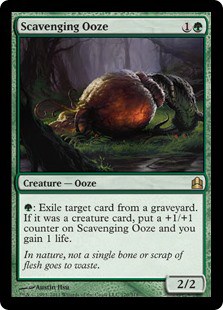
Dreadhorde and Oko, Thief of Crowns are great solutions to this issue . Oko can turn any sized Knight back into a bolt-able threat and Dreadhorde can turn a single Lightning Bolt into 6 damage. In my opinion, these printings have caused one of the biggest swings in a matchup I used to think was quite favoured for a patient Maverick pilot. Ooze is in a similar position to Knight, but thanks to the counters it gains, is a little harder to answer solely through an Oko.
I feel the matchup used to be slightly favoured for Maverick, but recent printings have revitalised RUG’s ability to deal with threats and has ultimately pushed ahead in the matchup.
Here’s a link to my favorite match caught on camera – Tom Herzaog on Maverick vs. Ben Weinburg on RUG Delver.
Which cards in RUG you think are notable in the matchup?
Delver of Secrets is one of the cards I want to see in my opening hands the most in this matchup. Getting off the ground early and taking to the skies can force the Maverick player to have a removal spell relatively quickly. This allows me to control the pace of threat deployment a bit more from the RUG side.
To that end, Dreadhorde Arcanist is the second most important card. By forcing Maverick to use its relatively limited removal on a Delver of Secrets, it makes the Arcanist more likely to stick around. It’s likely that an experienced Maverick player will save their removal spell for the Arcanist, but that only makes the Delver that much more important. Every aspect of Delver’s game plan is exacerbated by having its namesake card chipping in for 3 damage a turn as early as possible.
Backing up this extremely powerful 1-2 curve is Lightning Bolt, which probably doesn’t need much introduction in this matchup. The fact that Lightning Bolt is so efficient allows the Delver player to assume the control role in many situations, and combining it with a Delver or 2 can really put Maverick on the back foot. Beyond being an incredible removal spell, Bolt (especially in conjunction with Delver of Secrets) can allow the Delver player to assert an aggressive game plan that can simply ignore what Maverick is doing and race them.
Maverick is weak to aerial attacks as it tends to only run 1 flyer in Scryb Ranger and no creatures with reach (Shifting Ceratops is seeing some sideboard play). The pro-blue effect is fantastic at holding off a Delver of Secrets, but RUG has many ways to deal with Ranger so it’s not a viable strategy to rely on. I’ve played in countless matches where a T1 Delver has taken RUG to victory because the pilot has countered any removal spells I was able to draw and not worried about my grounded board presence.

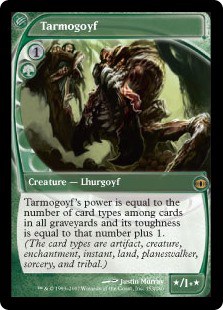

The ‘protect the queen’ strategy of Delver players can be a highly rewarding route to victory as Maverick doesn’t have too much choice over when or how many removal spells it sees in a game. GWB Maverick has the huge bonus of Abrupt Decay in its removal suite, which destroys any plans for the RUG player to protect their main threat (outside of Hooting Mandrills). This is a huge reason why the Maverick archetype is considered the best positioned right now.
Now with Dreadhorde Arcanist in the matchup, there’s even more pressure on the Maverick player to have removal in the opening turns. Even though Delver is such a threat, I’m now less likely to fire off my first removal spell on Delver until I know it’s the threat they’re focusing on. It’s a tough learning curve, but using your life total as a resource early on to get the most amount of information out of your opponent before casting removal is key to keeping your head above water in this matchup. This is a matchup where I want to be patient with my removal, sometimes taking the time to untap and play around Daze if possible (most likely waiting for their next upkeep to also play around Force of Negation in G1).
Do you have any thoughts on which archetype is easier / harder to beat?
I find that the Abzan version of the deck is the most problematic to play against. The presence of Abrupt Decay can really shift the dynamic of what RUG can rely on, and it makes the aggressive plan much more difficult to execute. It’s not just the extra removal, but the uncounterable nature of it (and the ability to answer Oko) add up to give Maverick a bump in the matchup.
Beyond that, I find a lot of the other versions very similar to play against, and the play patterns don’t change too much. Each variant has some problematic cards (Naya having Klothys and Bant having Uro/Oko), but if my opponent is resolving a Green Sun’s Zenith for 3, I’m usually more concerned with Knight of the Reliquary (plus, I might be in dire straits already).
As stated above, I believe GWB Maverick has the best matchup right now against RUG Delver purely due to Abrupt Decay being such an important removal piece. One piece of advice is making sure you’re not opening yourself up to Wastelands on your black mana sources in the early turns, and not having it for when you need to cast Decay. RUG players are very good at targeting a splash colour with Wasteland and putting you in a position where you can’t cast your spells.
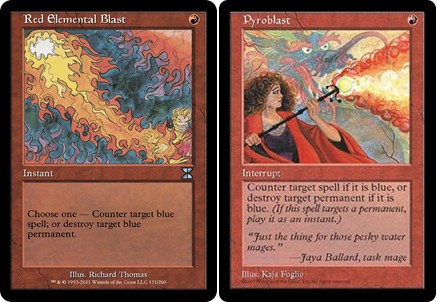
GWR Maverick also has the bonus of Red Elemental Blast and Pryoblast as additional removal for Oko and Delver in the board and a formidable in Kloyths. The matchup can be a very quick death or a lengthy battle of resources – the hard part is working out which one your specific game is going to be. Kloyths is great in the grindy, dragged out games, but may be too slow for some of the Delver / Dreadhorde starts from RUG.
BANT Maverick is an interesting choice for the matchup as well, thanks to Uro being an all-star at keeping your life total above the red and gaining some advantage each time it hits the board. Although it can be hit with Bolt & Arcanist or Oko, the damage has usually been done by the time your RUG opponent has dealt with it.
Straight GW Maverick has a huge advantage in its mana. GW can play up to 5 basics, which is huge against a deck that likes to aggressively attack Maverick’s mana. You’re not going to get stuck with cards in hand, and you now have more maindeck removal in Skyclave Apparition. A big weakness of GW in the past was having access to only 4 removal spells in Swords to Plowshares, but now with Skyclave, that figure has jumped to 6-7. I believe Skyclave was the best printing for Maverick in 2020 and has given all archetypes more options for maindeck removal.


Shifting Ceratops is a threat I want to shout out here as it’s currently very well positioned, especially against Delver strategies. It gets blanked by Mandrills and Goyf, but otherwise it’s a fast, uncounterable, un-Submerge-able, un-Oko-able threat. I’ve also had the pleasure of blocking an Insectile Aberration because my opponent didn’t read it.
I think all versions of Maverick have some real advantages against RUG, but it’s very hard to now choose the variant 2-3 maindeck Abrupt Decays in the current metagame.
4. RUG Delver’s Game Plan
What cards do you find troublesome from Maverick’s side in G1?
As far as individual cards are concerned, Scavenging Ooze and Knight of Reliquary are the two most effective threats in the matchup. Both have the ability to outgrow Lightning Bolt, which is problematic in its own right, but each of them disrupt an element of RUG’s game plan. An unchecked Ooze can easily keep RUG’s aggression at bay and completely halt a ground assault while regaining crucial life points along the way. Knight of the Reliquary can halt ground assaults in much the same way but also threatens to Wasteland RUG every turn, which can seriously hinder development. Questing Beast can also be a problem, but since it’s a bit more expensive, it can be easier to manage with a Daze.
This is a really tricky question to answer from Maverick’s side. For me, it’s not a single card and more about the pilot’s approach to the matchup.
Some RUG players go hard on mana denial, bolting mana accelerates and firing off Wasteland on first chance. Some like to build out their board with a threat then use cantrips to mould their hand into one that’s going to be unbeatable. Then there are others who just slam threats every turn until one sticks.
Delver is tough because it’s no longer the threat that you need to focus on, but it’s going to win the game if you don’t. Focusing all your energy on a Delver is only going to leave you vulnerable against a Dreadhorde or Oko. Hooting Mandrills is another heavy hitter that can be awkward for players who have used their Plows early on and are left with Skyclave or Decay that are useless against the 4/4 beater. Tarmogoyf is a little easier to manage, but now that the deck can produce 5/6 Goyfs quite easily, they can also close out games very quickly.
Thankfully Submerge isn’t a maindeck card for RUG, so once your Knights or Ooze become too big for even a Dreadhorde to handle, it all comes down to Oko to reduce their power on the game.
If I was to class RUG’s threats, you now have vanilla beaters in Delver, Goyf and Mandrills and value engines in Oko and Dreadhorde. Brian Coval has recently been talking about ‘Bane-drifters’ which are creatures that have both the power of a threat like Baneslayer Angel but also the value of Mulldrifter. These are ultimately the threats I’m afraid of and what should be given as much respect as possible.
5. Sideboarding Strategy
How do you tend to sideboard against Maverick?
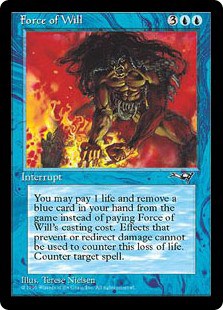


Out (on the draw): 2 Force of Negation | 2 Daze | 2 Force of Will
Out(on the play): 2 Force of Negation | 4 Force of Will
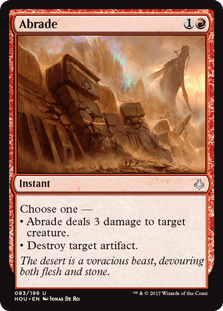
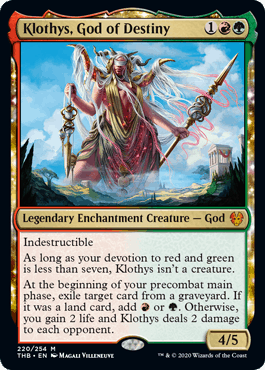

In: 2 Rough/Tumble | 2 Submerge | 1 Abrade | 1 Klothys, God of Destiny
My sideboarding tends to involve a lot of off-the-cuff decision making, so it’s much less a science and more of an art, in that regard. While this configuration I’m suggesting is relatively smooth, there are a lot of different things that will lead to me adjusting things, such as what cards I see and what my opponent’s play patterns tend to be like.
That being said, in general, I don’t love Force of Will. There are some key cards that are important to stop, but most blue cards are pretty decent in the matchup, so there is usually a dearth of good pitch fodder. Daze can be effective, but on the draw it’s not just that it is far more likely to be dead (it is), but even if you can counter a card, it will often set you too far behind.
There are situations where I’ll either want to leave in some extra Force of Wills or find it necessary to bring in some other cards (such as an extra Klothys against Uro or an Ancient Grudge against Stoneforge Mystic). If that ends up being the case, the two cards I’ll start looking to trim in the matchup are Tarmogoyf and Preordain. For instance, if my opponent casts a card like Mother of Runes against me, Tarmogoyf gets a bit worse as it is pretty easy for them to keep in check. I tend to sideboard out cantrips a bit more than the average Delver player so take that suggestion with a grain of salt, but if I see my opponent really leaning into Thalia as a game plan (or if they bring in Chalice), I will happily cut a Preordain to reduce the amount of draws where I end up floundering around while my opponent is developing.
For Maverick, I would do something like below. I’ve also added in my Inside the Maverick with Achillies27 where we discuss the RUG Delver matchup and sideboarding a little more.
Out: 1 Collector Ouphe | 2 Plague Engineer | 1 Once Upon a Time
In: 3 Path to Exile | 1 Vraska, Golgari Queen
What do you expect from Maverick’s board?
Many of Maverick’s cards are decent in the matchup, so I don’t tend to expect much from the board. Choke is one of the cards I fear the most, and is primarily the reason I leave in some number of Force of Wills on the draw. Choke doesn’t seem to be too common these days, but it’s certainly always on my mind. Beyond that, I generally expect some extra removal spells and not much else. If I had access to my opponent’s deck list mid-match and saw that they had cards like Vraska (such as in your reference list), I would probably anticipate that coming in.
More removal is key for Maverick. Path to Exile is perfect as RUG doesn’t tend to run basic lands and like Swords to Plowshares, it isn’t restricted like Decay or blast effects (Mandrills). If you have planeswalkers, they can also be relevant as fighting on more than just a creature axis can be tough for RUG to answer. It’s not just about having more removal in your maindeck, it’s about increasing your chances of having multiple pieces in your opening hand.
6. Tips & Tricks
There’s a lot of variation in the play patterns in this matchup, so don’t be rigid in your game plans. In general, I find Dreadhorde Arcanist to be important enough that I’ll fight over it with a Force of Will but that might leave you getting burned some amount of the time since Green Sun’s Zenith gives Maverick constant access to its best threats.
Be extremely mindful when casting Daze in the matchup. It can be really easy to lose the mana-development stage of the game and mistiming it can be a fatal mistake. Finally, be careful when using Oko to turn a card like Questing Beast into an Elk, as it retains its legendary status and can be bounced with Karakas.
Although it’s not seeing much play these days, some versions of RUG are still playing a number of Stifle. This means if your opponent has open blue mana and you have a Wasteland, you should fire it off in their upkeep rather than during your turn. This means if your opponent does have the Stifle, they are tapping out on their turn rather than yours.
This is a pretty specific situation but I’ve now seen it a few times that I believe it’s worth discussing.
If you play a spell with Wasteland up and your opponent responds with a Wasteland on your Wasteland, take a moment to think about what they want to achieve here. What could be happening is your opponent is baiting you to respond with activating your own Wasteland on one of their duals (Tropical Island / Volcanic Island)? This can be a huge blowout, where your opponent uses Daze on your spell to return the dual you targeted and now you’re down a land and a spell. It could just be better in this situation to tap the Wasteland for mana and let it go to the bin.
7. Conclusions
I definitely find this to be a fun matchup and both sides will have a lot of decisions over the course of a game. In many ways it feels like an old-school Legacy midrange battle, which definitely makes it something to look forward to.
Maverick is one of my favorite decks, and it’s awesome to see you provide some excellent content on the archetype! Thanks for having me!
The Maverick vs. RUG Delver matchup is still one of the matchups I consider to be the most enjoyable for both players. The decks have some great answers to each other, and the amount of decisions you have makes every game different. As a Maverick player, be patient and make sure you’re giving each of your removal spells as much chance of resolving as possible. Respect the Delver but don’t be too hasty on removing it from play.
A huge thank you to Rich for coming on the GreenSunsZenith and talking about RUG Delver. If you want to reach out to Rich or enquire about his coaching sessions, you can find him on the following platforms:
– Twitter
– Channel Fireball
What do you want to see next? Let me know in the comments below!
8. Previous Matchup Series
1. Maverick vs. Eldrazi Aggro Feat. Achillies27
9. Coverage & Resources
Rich Cali on RUG Delver vs David Thomas Tao on Maverick
MTGO Coverage
Here are timestamps to leagues, prelims and Eternal Weekend where I’ve played against RUG Delver. If you enjoy this content, consider subscribing to my YouTube channel!
GW Maverick
GW Maverick vs RUG Delver
GW Maverick vs RUG Delver
GW Maverick vs RUG Delver
GWB Maverick
GWB Maverick vs. RUG Delver
GWB Maverick vs. RUG Delver
GWB Maverick vs. RUG Delver
GWB Maverick vs. RUG Delver
GWB Maverick vs. RUG Delver
Eternal Weekend 2020
GWB Maverick vs. RUG Delver
GWB Maverick vs. RUG Delver
GWB Maverick vs. RUG Delver
GWB Maverick vs. RUG Delver
4C Maverick
Dark BANT Maverick vs RUG Delver
Dark BANT Maverick vs RUG Delver
Dark BANT Maverick vs RUG Delver




